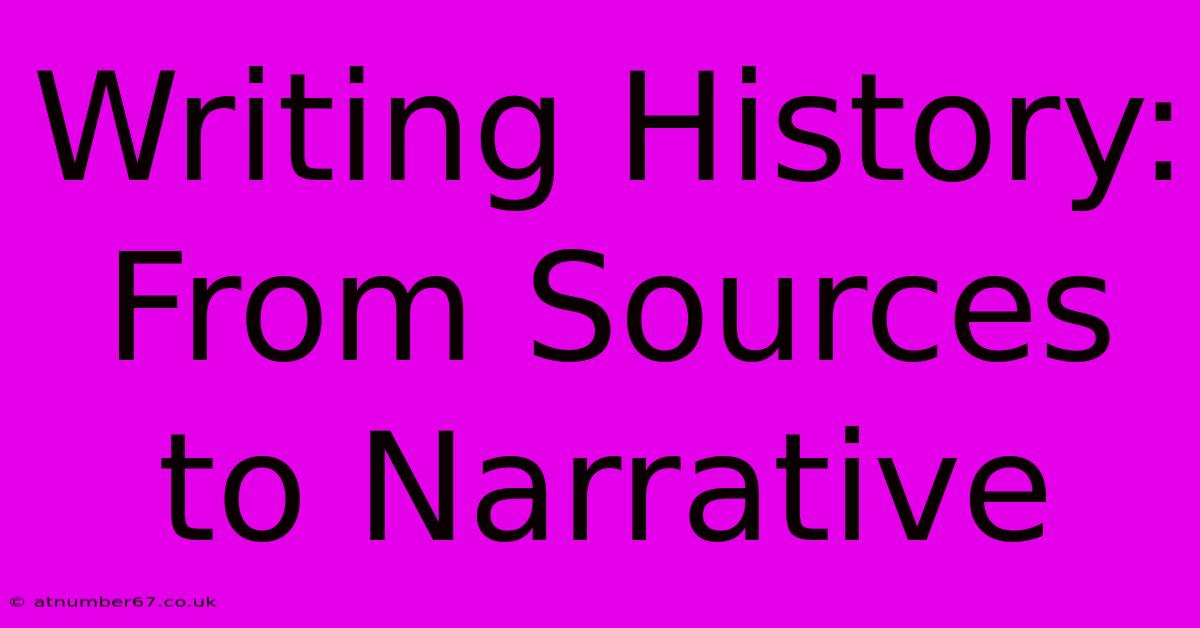Writing History: From Sources To Narrative

Table of Contents
Writing History: From Sources to Narrative
History isn't just a collection of dates and names; it's a compelling narrative constructed from fragments of the past. Writing history involves a meticulous process, transforming raw sources into a coherent and engaging story. This article explores the crucial steps involved, from identifying reliable sources to crafting a compelling narrative that resonates with readers.
Unearthing the Past: Finding and Evaluating Sources
The foundation of any historical work lies in its sources. These can range from primary sources—direct evidence from the period being studied, such as letters, diaries, government documents, and artifacts—to secondary sources—interpretations and analyses of primary sources by historians.
Primary Sources: The Cornerstone of Historical Research
- Identifying Primary Sources: Libraries, archives, museums, and online databases are treasure troves of primary sources. Knowing where to look, depending on the historical period and subject, is crucial.
- Evaluating Primary Sources: Critical evaluation is paramount. Consider the author's bias, the context of creation, and the potential for inaccuracies or manipulation. Cross-referencing information from multiple primary sources is essential for verification.
- Examples of Primary Sources: Original manuscripts, photographs, maps, oral histories, and even physical objects can serve as primary sources, offering unique perspectives on the past.
Secondary Sources: Building on the Foundation
- Utilizing Secondary Sources: Secondary sources provide context, analysis, and different interpretations of events. They help historians synthesize information and develop a more nuanced understanding.
- Evaluating Secondary Sources: Just as with primary sources, critical evaluation is necessary. Consider the author's credentials, their perspective, and the date of publication. Look for evidence of thorough research and balanced arguments.
- Examples of Secondary Sources: Scholarly articles, books, documentaries, and even reputable websites can serve as valuable secondary sources.
Weaving the Narrative: Constructing a Historical Account
Once you have gathered and evaluated your sources, the task of transforming them into a compelling narrative begins. This involves several key steps:
Developing a Thesis Statement:
A strong thesis statement—a concise statement of the main argument—provides a roadmap for your historical account. It focuses your research and guides the reader's understanding.
Organizing Your Information:
Organize your findings chronologically, thematically, or geographically, depending on the nature of your historical subject. A well-structured narrative is easy to follow and enhances understanding.
Analyzing and Interpreting Sources:
Go beyond simply summarizing your sources. Analyze the information, identify patterns, draw conclusions, and offer insightful interpretations. This is where your own historical skills and critical thinking come into play.
Constructing a Compelling Narrative:
Use vivid language, engaging storytelling techniques, and insightful analysis to draw your reader into the historical period. Humanize the past by focusing on individuals, their motivations, and the impact of historical events on their lives. Remember, history is not just about facts; it's about the human story.
Beyond the Page: Ethical Considerations and Presentation
Writing history is not without its ethical responsibilities. Accuracy, objectivity (as much as possible), and a commitment to representing all perspectives fairly are crucial. Proper citation and attribution of sources are also essential to maintain academic integrity. Finally, consider how best to present your historical work, whether in an academic paper, a book, a documentary, or another medium.
Keywords: writing history, historical research, primary sources, secondary sources, source evaluation, historical narrative, thesis statement, historical analysis, historical writing, academic integrity, historical methodology.
This article provides a comprehensive overview of the process of writing history, from locating and evaluating sources to constructing a compelling and engaging narrative. By following these steps, aspiring historians can create accurate, insightful, and captivating accounts of the past.

Thank you for visiting our website wich cover about Writing History: From Sources To Narrative. We hope the information provided has been useful to you. Feel free to contact us if you have any questions or need further assistance. See you next time and dont miss to bookmark.
Featured Posts
-
Ruth Ellis Son A New Beginning
Apr 13, 2025
-
Tinubus 2024 Wealth A Forbes Investigation
Apr 13, 2025
-
The Tommys Dad Mystery East Enders Fans React
Apr 13, 2025
-
Brian Littrells Son The Family He Built
Apr 13, 2025
-
Diego Simeone S Son His Secret To Success
Apr 13, 2025
